NON-FOOTBALL
STORIES 1891
While looking through old documents, it is almost inevitable that the reader's
attention will be drawn from the intended target to other articles. Most of
the reports below were found in old Ardrossan and Saltcoats Heralds. Although
they have no football content, they may be of interest.
SICK POOR OF ARDROSSAN
It may not be generally known that for twelve months, through the liberality
of a number of generous friends, Miss Wright has been employed in Ardrossan
as a sick nurse in cases of sickness in families whose circumstances could not
afford skilled help. From the report to be issued in a few days, we observe
seventy-four cases have been dealt with and a number of the cases noted were
of such a nature as to show the necessity that existed for such a benevolent
agency. Now that the scheme has proved itself to be a good one by its fruits,
the hope may be cherished that it will not fail for want of funds. "I was
sick and ye visited me." The income for the year, we observe, was £44
13s 4d and the expenditure was £44 8s 7d giving a balance on hand of 4s
9d.
Ardrossan
and Saltcoats Herald, 30 January 1891
OVERCROWDED COWSHED
A report by the Sanitary Inspector on the various matters falling within his
province was submitted and read. The report stated that the complaint regarding
overcrowding of a cowshed had been obviated by the owner of the cows having
reduced their number and the premises were now in a satisfactory state.
Minute
Book of the Local Authority of the Burgh of Ardrossan, 10 February 1891
A SUCCESSFUL ARDROSSAN YOUNG
MAN
We learn that Mr James Robertson, son of Mr John Robertson, harbour foreman,
was successful in passing as chief engineer at the Board of Trade examination
last week. Mr Robertson is a promising young man and it is hoped he has a prosperous
career before him.
Ardrossan
and Saltcoats Herald, 13 February 1891
CURLING
Curling was indulged in here by a number of local players on the Mill Pond (shown
below as Millglen Caravan Park in 2006) on Wednesday (11 March 1891) with great
interest. The ice was in very good condition up till the afternoon when a slight
thaw set in.
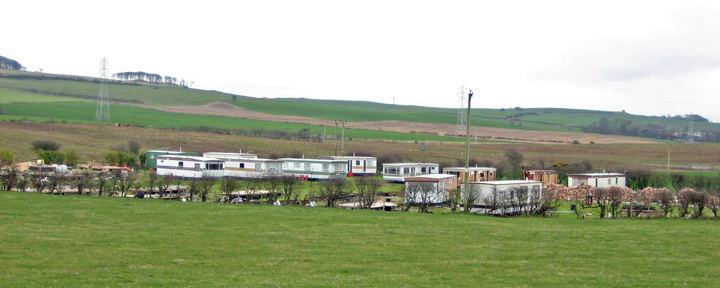
Ardrossan
and Saltcoats Herald, 13 March 1891
PEN AND PENCIL CLUB
As will be seen from our advertising columns, a preliminary meeting of this
club is being held on Monday first (16 March 1891). It is hoped there will be
a good attendance.
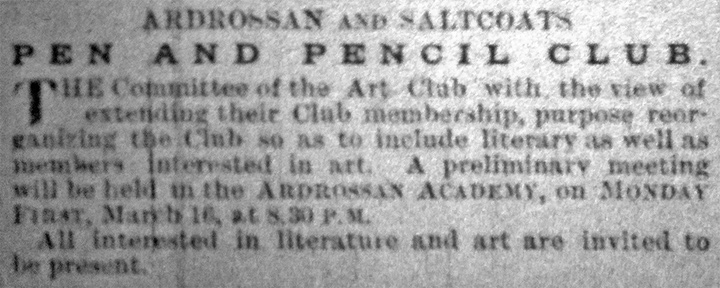
Ardrossan
and Saltcoats Herald, 13 March 1891
YOU NEVER THE MISS THE WATER TILL THE WELL RUNS DRY
'You never miss the water till the well runs dry' is a proverb the truth of
which was brought home to some of our townsfolk last Sunday morning (15 March
1891). Even in this reading age, odd specimens are occasionally met who can't
or who won't read the newspapers. Consequently, these benighted individuals,
not having perused a report of the proceedings at the last monthly meeting of
the Ardrossan Commissioners, were unaware of their intention, as expressed by
the Provost, to turn off the water supply from Saturday night till Monday morning.
Others again who suffer from that commonest of failings - a bad memory - having
read the notice made up their minds to be prepared against a scarcity by laying
in a stock of water on Saturday evening but, putting down the paper, they straightway
turned their attentions to other matters and forgot all about their little plans
till they went to perform their ablutions on Sunday morning. However, as water
was available at most of the washing-house taps, things were hardly so bad as
during a water famine at a neighbouring watering-place a couple of summers ago
when we heard of a worldly couple who were reduced to such terrible straits
that the husband had to use a glass of beer to shave with while the missus washed
her face in a bottle of lemonade.
Ardrossan
and Saltcoats Herald, 20 March 1891
FIRE AT CALEDONIAN RAILWAY
STATION
Early on Saturday morning (14 March 1891), the Caledonian Railway Station (shown
below in the early 1910s) narrowly escaped being seriously damaged by fire.
It seems that one of the workmen was passing through the pan-house with a kindling
when some of the ashes fell among sawdust and oil which were lying on the floor
near a case of glass and straw, a lot of empty wastebags and two barrels of
oil. A boy in Montgomerie Street observed flames issuing forth from the windows
and gave the alarm at the station and the fire was extinguished before oil barrels
burst but the other materials were burned. The roof of the pan-house was slightly
damaged.
Ardrossan
and Saltcoats Herald, 20 March 1891
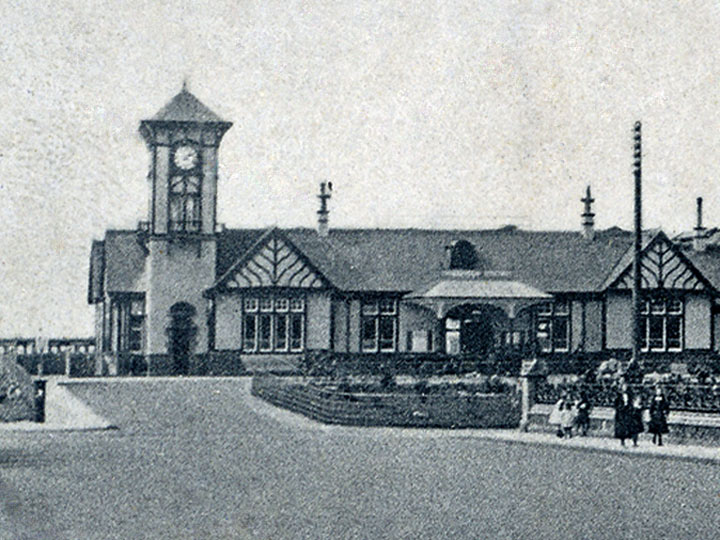
WHEELING BARROWS AND BOGIES ON THE PAVEMENT
At the Ardrossan Burgh Court on Monday morning, Provost Hogarth presiding, a
porter at the Caledonian Railway Station (shown above in the early 1910s) and
two small boys appeared to answer to a charge of wheeling vehicles on the pavement
to the damage of same and the annoyance of pedestrians. They each pled guilty
the former alleging in extenuation that he did not know that he was in fault
and thought the policeman was joking when he warned him off. They were each
dismissed with an admonition.
Ardrossan
and Saltcoats Herald, 20 March 1891
ARDROSSAN SINGING PRIZEWINNER
Miss Mary Emslie, Ardrossan, was successful in gaining the second prize at a
competing for the best rendering of Scottish songs held in Mr Julius Seligmann's
Conservatoire of Music, Glasgow last Saturday afternoon (4 April 1891).
Ardrossan
and Saltcoats Herald, 10 April 1891
THE LATE ARCHIBALD DOUGLAS
BRYCE-DOUGLAS OF SEAFIELD
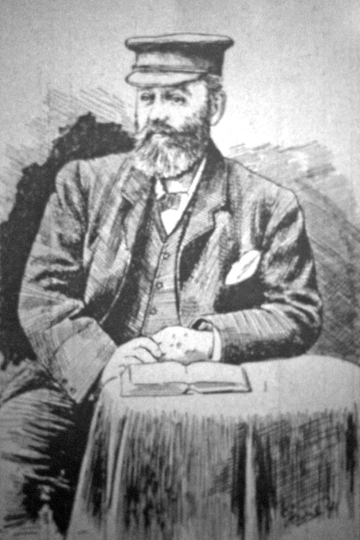 On
the morning of Sabbath 29 March, Mr A D Bryce-Douglas (shown right around 1890
from a photograph by John Fergus of Largs) landed at Ardrossan from the Empress
of Japan, then on her trial trip and after a week of severe suffering died at
Seafield Tower, his residence here on the morning of Sabbath last (4 April 1891).
Need we say a shadow of a great sorrow hung over the community of Ardrossan
all week. It was known that Dr Macdonald was in all but constant attendance,
that Dr Moore, Glasgow, made daily visits, that enquiries by telegraph were
coming from all parts of the country and day by day the first enquiry in the
morning and the last at night was an anxious enquiry as to his condition and
this and this anxiety was not to be wondered at. The parish was proud of the
eminence he had attained as a marine engineer. He was the son of their old parish
minister whose qualities as a preacher and freedom from denominational prejudices
were still remembered. He had purchased Seafield Tower because of old it had
been in the family. The poor he had helped. The New Parish Church had the benefit
of his large-hearted generous contributions for late improvements and hundreds
of young men were indebted to him for situations at Fairfield, at Barrow and
in other parts of the world. All this had endeared him to the community. He
was looked up to because of his genius for unquestionably, he was a mechanical
genius of a high order. He was respected for his great administrative abilities
as a large employer. He was one of the kings of labour and liked for his warm-hearted
kindly deeds, his frank intercourse with gentle and simple and his independent
bearing. When his death became known, there was everywhere in the district an
expression of sincere sorrow. It was felt that Commerce had sustained a great
loss and that the poor and the needy were the poorer and the more helpless because
he had passed away. Nor was this feeling confined to his native parish. All
last week, a like anxiety was felt by all classes at Barrow, by Lord Harrington
and the other noblemen and gentlemen associated with him in the works there
and when the news of his death became known, public testimony was borne to the
respect in which he was held by the display of flags half-mast high on public
buildings, on public works, on shipping and elsewhere. Mr Bryce-Douglas was
born at The Manse, Saltcoats on 3 October 1840 being the youngest son of the
late Reverend John Bryce, parish minister of Ardrossan. He was educated at Irvine
Academy under Dr White, master of the Commercial department and afterwards at
Glasgow High School under Dr Bryce, finishing at the university. Like many another
son of the manse, young Bryce was destined by his parents for the ministry of
the church but his bent lay in another direction and as from his earliest days,
he had a mind and a will of his own. His father wisely gave way and allowed
him to carve out his own path through life. Indeed, if it be true that the boy
is father to the man in the case of those who rise to distinction, it was so
in his. 'Still life' was unknown to him as a boy. His restless energy even then
was conspicuous. When seventeen years of age, he was apprenticed to Mr Robert
Drape, joiner, Ardrossan with whom he remained for two years. He also served
for one year as a mill-wright with Mr Hendry, West Kilbride but not yet had
he found his vocation and at the end of that time, he removed to Glasgow and
entered the engineering establishment of Randolph, Elder and Company then situated
in Centre Street, in the evenings attending classes for the study of mechanics
at the Andersonian University. In Messrs Randolph, Elder and Company's employ,
he found congenial work and throwing himself into it with all the ardour of
his nature, he soon attracted the attention of Mr Randolph, the head of the
firm who predicted for him, even at that early age, a distinguished career but
he was not content to remain for more than a few years in the Centre Street
establishment. He had always been possessed by a spirit of adventure and early
in the sixties he shipped as a passenger in a sailing vessel for Auckland where
he had the promise of taking charge of an important machinery plant. On the
way out, the carpenter died and Mr Bryce was offered and accepted the situation
rendered thus vacant. On arriving in New Zealand, the Maori war had just broken
out and taking the situation in at a glance, he soon found an opportunity of
working his passage with a well-known captain with one of our ocean liners to
the Pacific coast. For about a year, he was in the service of the Peruvian Navy
at the end of which time he was offered and accepted a situation as seagoing
engineer with the Pacific Steam Navigation Company. In the year 1865, he revisited
Scotland and after taking a few months with his friends and taking his examination
for extra first-class engineer, in which he was successful, he returned to Callao
to become assistant engineer of the Pacific Company. This position he occupied
till 1869. In that year, the headquarters of the company were removed from the
island of Tobogo in the Bay of Panama to Callao on the establishment of a line
of steamers to sail direct between Liverpool and Valparaiso and a vacancy taking
place at the same time in the office of the superintending engineer through
the resignation of Mr Jamieson. Mr Bryce received the appointment which he held
for a period of six or seven years. On his way home an incident occurred which
was an index of the character of the man. A small coal-laden vessel had stranded
in the Bay of Panama. He took with him, from Callao, a staff of men and the
necessary appliances with the view of raising her. On arriving in the bay, he
learned that the Tagus, one of the Royal Mail Company's steamers had gone ashore
near Colon. Unable, on account of the heavy sea, to accomplish the work he had
come to do, he crossed the Isthmus with his staff and appliances and successfully
carried out the more difficult of raising the Targus. The other vessel was also
raised in due course, Mr Bryce, not only directing, but taking an active part
of working in the diving bells and repairing the hulls, his fertility of resource
being displayed on occasion by the employment of a locomotive to work the pumps.
For the raising of the steamer, the Pacific Company claimed £30000 as
salvage on the ground that Mr Bryce had used their appliance. This claim Mr
Bryce resisted and raised an action in the Court of Session which proved unsuccessful.
On carrying his case, however, to the House of Lords, his contention was partially
sustained and he received a sum of £6000. Shortly after his return to
this country, Mr Bryce resumed his connection with the firm in which he had
received his early training becoming head of the engineering department at the
Fairfield Works which were then carried on under the denomination of Messrs
John Elder and Company. He had found, as told us, the first month of absolute
rest delightful after the close attention of everyday work of previous years,
the second became wearisome and before the close of the third, he was again
glad to be in harness. He remained at the Fairfield Works until he removed to
Barrow in 1888. The history of the Fairfield Works during that period it is
unnecessary to recapitulate. Briefly, it may be stated it was during this time
that the Arizona, Alaska and Oregon and other vessels for the Cunard fleet were
built and that the revolution in the construction of ocean-going steamers, which
has not yet seen its close, was commenced. The whole of these vessels were engined
under the superintendence of Mr Bryce-Douglas as well as the Orient, the Austral
and the Ormuz for the Orient Line. He also constructed the engines for the Czar's
yacht, the Livadin for the Italian iron-clad Magicienne and for several of the
numerous vessels for the British Navy which were turned out of the Fairfield
yard. He also re-engined the Russian warship, Peter The Great. Mr Bryce-Douglas's
connection with Barrow commenced in 1886 when engines of his design were built
under his supervision for the Navigation Steam Navigation Company's Orula and
Orizaba which were constructed by the Barrow Shipbuilding Company. These were
two of the earliest examples of engines of the triple expansion type put into
ocean-going steamers. In 1888, influenced by Lord Harrington and other capitalists,
Mr Bryce-Douglas accepted the position of managing director of the Naval Construction
and Armaments Company which took over the works of the Barrow Shipbuilding Company.
The latter company had all along been an unsuccessful enterprise but, under
the new regime, several and extensions were made and new plant and machinery
were laid down. Important contracts were soon secured which rapidly brought
about a renewal of activity in the shipbuilding and engineering trades of the
port. Among the first orders, Mr Bryce-Douglas procured were four steamers of
large size and full power for the Pacific Steam Navigation Company, a number
of steamers for the British and African Steam Navigation Company and for Messrs
Elder, Dempster and Company of Liverpool. He also obtained the contract for
three second-class cruisers to be built for the Admiralty all of which have
been launched and one, the Latona, delivered while a second cruiser, the Melampus,
will be handed over to the Admiralty at the close of this month. He also undertook
the building of three high-speed 5000 tons steamers for the Caledonian Pacific
Railway Company and intended for the service between Vancouver and Japan and
China. The pioneer of these steamers, the Empress of India, is now on her way
from Hong Kong to Vancouver on her maiden voyage. The sister ship, the Empress
of Japan, ran most successful trials last week as reported in another column
and was taken over by her owners and the third steamer, the Empress of China
was launched a fortnight ago. In the yard, there are at present building nine
steamers of various sizes. There are over 5000 employees in the works and the
weekly payments in the shape of wages amount to about £8500. Thus, if
at Fairfield, Mr Bryce-Douglas made an advance on his achievements on the Pacific
coast by constructing swifter-sailing steamers than companies up till that time
constructed, it was at Barrow where he gave the fullest token of what he was
capable of accomplishing. The directors had the fullest confidence in him, a
confidence justified by his few years of management and with practically a free
hand, he was further a development both as respects increased speed and beneficial
results to commerce and civilisation which would have marked a new era in steam
navigation. Long ago, at Fairfield, the idea was conceived of crossing the Atlantic
by fast-sailing steamers of twin-screw, triple-expansion type from Liverpool
to Canada in five days and then by equally fast-sailing steamers from Vancouver
to Australia thus developing new routes to the east and establishing a new direct
line from England to Australia, crossing the British territory of Canada by
the Canadian Pacific Railway. Last autumn, he visited Canada to take the initiative
in this great scheme and the Premier of the dominion, Mr John MacDonald granted
him a grand subsidy of $750000 per annum for ten years if he would establish
the line. Had he lived to carry out this scheme, it would have been regarded
as one of the greatest conceptions in the history of Commerce and for the sake
of the great works at Barrow, with which from henceforth his name will ever
be connected, it is hoped that the proposed Imperial Steam Navigation Company
will be formed and the enterprise entered upon in the spirit and confidence
which commands success. No better monument could be raised to the memory of
him whom Lord Brassey, at the launch of the cruiser Naiad, said was "a
great benefactor to the place" than by realising his dream and for which
it is said he had secured nigh a million of money. The immediate cause of death
was a cold caught, it is believed, at the launch of the Empress of China and
which developed into peritonitis. He was ill on board and was prescribed for
by a medical gentleman of the party and when he landed at Ardrossan on a bitterly
cold morning, he was able to walk to Seafield. No time was lost in calling in
medical aid and all that human skill and good nursing could do was done for
him. The inflammation, however, had got too firm a hold and a constitution,
remarkable for its strength, succumbed and at the comparatively early age of
fifty, a life of much usefulness and still greater promise came to a close.
He had probably when at sea faced death too often to dread the approach at the
last. This at least is certain, that when told the illness might have a fatal
termination, he received the tidings with the greatest calmness and with the
utmost composure, awaited the end. Beside possessing several patents, Mr Bryce-Douglas
was proprietor of Seafield, Ardrossan (shown below left as Quarriers in 2008)
which he purchased from the liquidation of the City of Glasgow Bank and greatly
enlarged and beautified.
On
the morning of Sabbath 29 March, Mr A D Bryce-Douglas (shown right around 1890
from a photograph by John Fergus of Largs) landed at Ardrossan from the Empress
of Japan, then on her trial trip and after a week of severe suffering died at
Seafield Tower, his residence here on the morning of Sabbath last (4 April 1891).
Need we say a shadow of a great sorrow hung over the community of Ardrossan
all week. It was known that Dr Macdonald was in all but constant attendance,
that Dr Moore, Glasgow, made daily visits, that enquiries by telegraph were
coming from all parts of the country and day by day the first enquiry in the
morning and the last at night was an anxious enquiry as to his condition and
this and this anxiety was not to be wondered at. The parish was proud of the
eminence he had attained as a marine engineer. He was the son of their old parish
minister whose qualities as a preacher and freedom from denominational prejudices
were still remembered. He had purchased Seafield Tower because of old it had
been in the family. The poor he had helped. The New Parish Church had the benefit
of his large-hearted generous contributions for late improvements and hundreds
of young men were indebted to him for situations at Fairfield, at Barrow and
in other parts of the world. All this had endeared him to the community. He
was looked up to because of his genius for unquestionably, he was a mechanical
genius of a high order. He was respected for his great administrative abilities
as a large employer. He was one of the kings of labour and liked for his warm-hearted
kindly deeds, his frank intercourse with gentle and simple and his independent
bearing. When his death became known, there was everywhere in the district an
expression of sincere sorrow. It was felt that Commerce had sustained a great
loss and that the poor and the needy were the poorer and the more helpless because
he had passed away. Nor was this feeling confined to his native parish. All
last week, a like anxiety was felt by all classes at Barrow, by Lord Harrington
and the other noblemen and gentlemen associated with him in the works there
and when the news of his death became known, public testimony was borne to the
respect in which he was held by the display of flags half-mast high on public
buildings, on public works, on shipping and elsewhere. Mr Bryce-Douglas was
born at The Manse, Saltcoats on 3 October 1840 being the youngest son of the
late Reverend John Bryce, parish minister of Ardrossan. He was educated at Irvine
Academy under Dr White, master of the Commercial department and afterwards at
Glasgow High School under Dr Bryce, finishing at the university. Like many another
son of the manse, young Bryce was destined by his parents for the ministry of
the church but his bent lay in another direction and as from his earliest days,
he had a mind and a will of his own. His father wisely gave way and allowed
him to carve out his own path through life. Indeed, if it be true that the boy
is father to the man in the case of those who rise to distinction, it was so
in his. 'Still life' was unknown to him as a boy. His restless energy even then
was conspicuous. When seventeen years of age, he was apprenticed to Mr Robert
Drape, joiner, Ardrossan with whom he remained for two years. He also served
for one year as a mill-wright with Mr Hendry, West Kilbride but not yet had
he found his vocation and at the end of that time, he removed to Glasgow and
entered the engineering establishment of Randolph, Elder and Company then situated
in Centre Street, in the evenings attending classes for the study of mechanics
at the Andersonian University. In Messrs Randolph, Elder and Company's employ,
he found congenial work and throwing himself into it with all the ardour of
his nature, he soon attracted the attention of Mr Randolph, the head of the
firm who predicted for him, even at that early age, a distinguished career but
he was not content to remain for more than a few years in the Centre Street
establishment. He had always been possessed by a spirit of adventure and early
in the sixties he shipped as a passenger in a sailing vessel for Auckland where
he had the promise of taking charge of an important machinery plant. On the
way out, the carpenter died and Mr Bryce was offered and accepted the situation
rendered thus vacant. On arriving in New Zealand, the Maori war had just broken
out and taking the situation in at a glance, he soon found an opportunity of
working his passage with a well-known captain with one of our ocean liners to
the Pacific coast. For about a year, he was in the service of the Peruvian Navy
at the end of which time he was offered and accepted a situation as seagoing
engineer with the Pacific Steam Navigation Company. In the year 1865, he revisited
Scotland and after taking a few months with his friends and taking his examination
for extra first-class engineer, in which he was successful, he returned to Callao
to become assistant engineer of the Pacific Company. This position he occupied
till 1869. In that year, the headquarters of the company were removed from the
island of Tobogo in the Bay of Panama to Callao on the establishment of a line
of steamers to sail direct between Liverpool and Valparaiso and a vacancy taking
place at the same time in the office of the superintending engineer through
the resignation of Mr Jamieson. Mr Bryce received the appointment which he held
for a period of six or seven years. On his way home an incident occurred which
was an index of the character of the man. A small coal-laden vessel had stranded
in the Bay of Panama. He took with him, from Callao, a staff of men and the
necessary appliances with the view of raising her. On arriving in the bay, he
learned that the Tagus, one of the Royal Mail Company's steamers had gone ashore
near Colon. Unable, on account of the heavy sea, to accomplish the work he had
come to do, he crossed the Isthmus with his staff and appliances and successfully
carried out the more difficult of raising the Targus. The other vessel was also
raised in due course, Mr Bryce, not only directing, but taking an active part
of working in the diving bells and repairing the hulls, his fertility of resource
being displayed on occasion by the employment of a locomotive to work the pumps.
For the raising of the steamer, the Pacific Company claimed £30000 as
salvage on the ground that Mr Bryce had used their appliance. This claim Mr
Bryce resisted and raised an action in the Court of Session which proved unsuccessful.
On carrying his case, however, to the House of Lords, his contention was partially
sustained and he received a sum of £6000. Shortly after his return to
this country, Mr Bryce resumed his connection with the firm in which he had
received his early training becoming head of the engineering department at the
Fairfield Works which were then carried on under the denomination of Messrs
John Elder and Company. He had found, as told us, the first month of absolute
rest delightful after the close attention of everyday work of previous years,
the second became wearisome and before the close of the third, he was again
glad to be in harness. He remained at the Fairfield Works until he removed to
Barrow in 1888. The history of the Fairfield Works during that period it is
unnecessary to recapitulate. Briefly, it may be stated it was during this time
that the Arizona, Alaska and Oregon and other vessels for the Cunard fleet were
built and that the revolution in the construction of ocean-going steamers, which
has not yet seen its close, was commenced. The whole of these vessels were engined
under the superintendence of Mr Bryce-Douglas as well as the Orient, the Austral
and the Ormuz for the Orient Line. He also constructed the engines for the Czar's
yacht, the Livadin for the Italian iron-clad Magicienne and for several of the
numerous vessels for the British Navy which were turned out of the Fairfield
yard. He also re-engined the Russian warship, Peter The Great. Mr Bryce-Douglas's
connection with Barrow commenced in 1886 when engines of his design were built
under his supervision for the Navigation Steam Navigation Company's Orula and
Orizaba which were constructed by the Barrow Shipbuilding Company. These were
two of the earliest examples of engines of the triple expansion type put into
ocean-going steamers. In 1888, influenced by Lord Harrington and other capitalists,
Mr Bryce-Douglas accepted the position of managing director of the Naval Construction
and Armaments Company which took over the works of the Barrow Shipbuilding Company.
The latter company had all along been an unsuccessful enterprise but, under
the new regime, several and extensions were made and new plant and machinery
were laid down. Important contracts were soon secured which rapidly brought
about a renewal of activity in the shipbuilding and engineering trades of the
port. Among the first orders, Mr Bryce-Douglas procured were four steamers of
large size and full power for the Pacific Steam Navigation Company, a number
of steamers for the British and African Steam Navigation Company and for Messrs
Elder, Dempster and Company of Liverpool. He also obtained the contract for
three second-class cruisers to be built for the Admiralty all of which have
been launched and one, the Latona, delivered while a second cruiser, the Melampus,
will be handed over to the Admiralty at the close of this month. He also undertook
the building of three high-speed 5000 tons steamers for the Caledonian Pacific
Railway Company and intended for the service between Vancouver and Japan and
China. The pioneer of these steamers, the Empress of India, is now on her way
from Hong Kong to Vancouver on her maiden voyage. The sister ship, the Empress
of Japan, ran most successful trials last week as reported in another column
and was taken over by her owners and the third steamer, the Empress of China
was launched a fortnight ago. In the yard, there are at present building nine
steamers of various sizes. There are over 5000 employees in the works and the
weekly payments in the shape of wages amount to about £8500. Thus, if
at Fairfield, Mr Bryce-Douglas made an advance on his achievements on the Pacific
coast by constructing swifter-sailing steamers than companies up till that time
constructed, it was at Barrow where he gave the fullest token of what he was
capable of accomplishing. The directors had the fullest confidence in him, a
confidence justified by his few years of management and with practically a free
hand, he was further a development both as respects increased speed and beneficial
results to commerce and civilisation which would have marked a new era in steam
navigation. Long ago, at Fairfield, the idea was conceived of crossing the Atlantic
by fast-sailing steamers of twin-screw, triple-expansion type from Liverpool
to Canada in five days and then by equally fast-sailing steamers from Vancouver
to Australia thus developing new routes to the east and establishing a new direct
line from England to Australia, crossing the British territory of Canada by
the Canadian Pacific Railway. Last autumn, he visited Canada to take the initiative
in this great scheme and the Premier of the dominion, Mr John MacDonald granted
him a grand subsidy of $750000 per annum for ten years if he would establish
the line. Had he lived to carry out this scheme, it would have been regarded
as one of the greatest conceptions in the history of Commerce and for the sake
of the great works at Barrow, with which from henceforth his name will ever
be connected, it is hoped that the proposed Imperial Steam Navigation Company
will be formed and the enterprise entered upon in the spirit and confidence
which commands success. No better monument could be raised to the memory of
him whom Lord Brassey, at the launch of the cruiser Naiad, said was "a
great benefactor to the place" than by realising his dream and for which
it is said he had secured nigh a million of money. The immediate cause of death
was a cold caught, it is believed, at the launch of the Empress of China and
which developed into peritonitis. He was ill on board and was prescribed for
by a medical gentleman of the party and when he landed at Ardrossan on a bitterly
cold morning, he was able to walk to Seafield. No time was lost in calling in
medical aid and all that human skill and good nursing could do was done for
him. The inflammation, however, had got too firm a hold and a constitution,
remarkable for its strength, succumbed and at the comparatively early age of
fifty, a life of much usefulness and still greater promise came to a close.
He had probably when at sea faced death too often to dread the approach at the
last. This at least is certain, that when told the illness might have a fatal
termination, he received the tidings with the greatest calmness and with the
utmost composure, awaited the end. Beside possessing several patents, Mr Bryce-Douglas
was proprietor of Seafield, Ardrossan (shown below left as Quarriers in 2008)
which he purchased from the liquidation of the City of Glasgow Bank and greatly
enlarged and beautified.
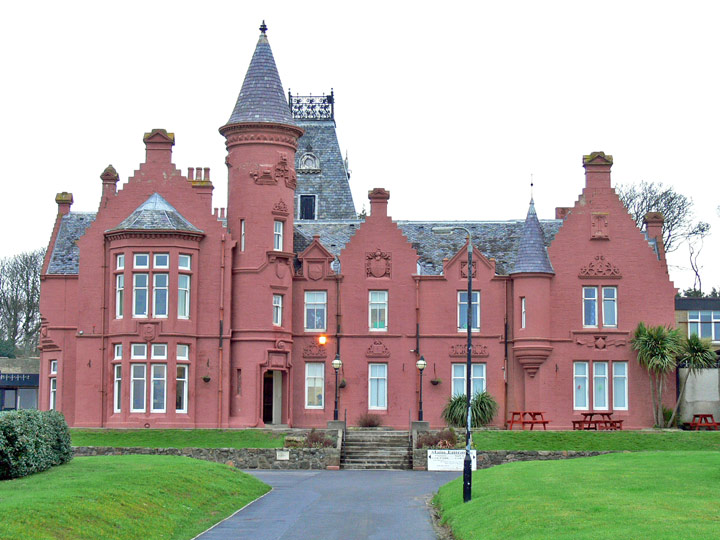
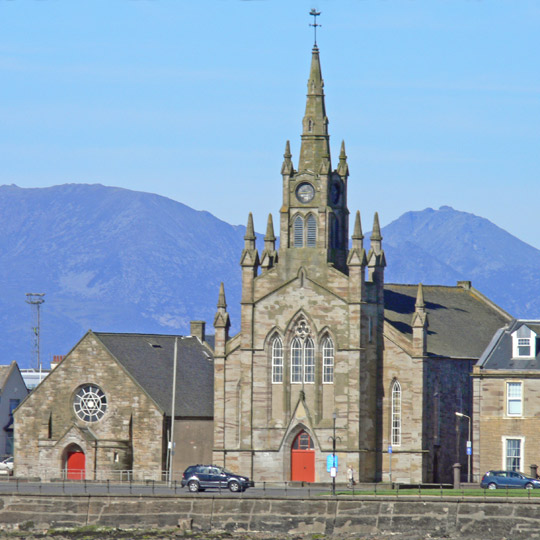
By inheritance, he was also the owner of Brownhill Estate in the parish of Dalry
and Burnbrae Estate, Dumbartonshire and it was when entering into the possession
of this last, on the death of his cousin Captain McAlister Douglas, that he
took the name of Douglas. In politics, Mr Bryce-Douglas was an advanced Liberal
and at the general election of 1885, he was approached with the view to his
being brought forward as a candidate for the representation of the Burgh of
Govan. Assurances were given of almost certain success but he declined to oppose
the late Sir William, then Mr William Pearse. He was also for some years an
honorary member of the executive of the Liberal Party of North Ayrshire and
as an indication of the estimation in which he was held by his professional
brethren, it may be mentioned that he was elected as their representative in
Lloyds new sub-committee by the Institution of Naval Architecture. He was married
to Miss Jessie Caldwell of Boydstone, Ardrossan, who died while they were resident
on the Pacific coast and her death was a great blow to him. She was survived
by one daughter but she also died about then years ago, another daughter predeceasing
her. Two of Mr Bryce-Douglas's sisters remain with many devoted friends to mourn
his sudden and unexpected death. The funeral took place on Wednesday (8 April
1891). In accordance with the expressed wish of the deceased, it was strictly
private and beyond the two male relatives, the trustees, representatives of
the Barrow works, one of the directors representing the board, and a representative
of the Canadian Pacific Railway only a few intimate friends were present. The
day was one of the finest of the season and all along the route from Seafield
to the cemetery, crowds of townspeople had gathered to see the cortege pass.
Before the coffin was placed in the hearse, the Reverend J D McCall of the New
Parish Church (shown above right as Barony Saint John's Church in 2009) conducted
a brief but impressive service and shortly thereafter the sad procession began.
Eleven mourning coaches followed the hearse and upon the coffin and in those
coaches in which the blinds were not drawn, beautiful wreaths of flowers could
be seen. As a public tribute to the memory of the deceased, the shops in the
town were closed between the hours of one and two and the bell of the New Parish
Church, of which he was a trustee, tolled. The wreaths were given by Mr Samson
Fox; Mr and Mrs Bagshawe, Leeds; Lord and Lady Edward Cavendishe, Holker Hall;
Sir James Ramsden, Abbotswood, Furness Abbey; Mr and Mrs Evans, Furness Abbey;
Mr and Mrs E H Clarke, Haverthwaite; Mr Joseph Mitchell, Rotherham; commercial
staff; managers and secretaries; draughtsmen; patternmakers; joiners; mechanics;
boilermakers; shipsmiths department; plumbers; foremen of the shipbuilding department;
caulkers of the shipbuilding department; engineers and brass finishers; platers
and angle-ironsmiths; riveters and shipwrights of the Naval Construction and
Armaments Company Limited, Barrow-in-Furness; tradesmen of Barrow; managers
and officials of the Barrow Hermatite Steel Company; president of the Canadian
Pacific Railway Company; Mr H Maitland Kersey of the Canadian Pacific Railway
Company; Dr and Mrs Macdonald, Ardrossan; Mr and Mrs McCulloch, Liverpool; Mr
Thomas Reynolds, London; Mr Daniel Taylor, Liverpool; Mrs Adamson, Barrow; Sir
William Pearse, Govan; relatives and men- and women-servants at Seafield. Among
those present at the funeral were Mr Robert Harvey, London; Mr Albert Vickers,
London; Mr Asplan Beldam of London; Mr R Ewing, Burnbrae, Perth, cousin of the
deceased; Mr James Caldwell, Blackshaw, brother-in-law of the deceased; Messrs
A M McCulloch, Liverpool; Alexander Comrie, Dalry, trustees; Mr James Wylie,
Border Farm, Saltcoats; Mr John Wylie, Mayfield Farm, Stevenston; Messrs C Dunderdale,
Glasgow; Alexander Macdowall, Glasgow; Mr R McAlpine, Bearsden; Dr Macdonald,
Ardrossan; Mr Hugh F Weir of Kirkhall; Messrs Henry Benham, director; A Adamson,
managing director, pro tem; Archibald Buchanan, shipyard manager; John Macgregor,
engineworks manager; John Hair, engineworks assistant manager, Naval Construction
and Armament Company, Barrow; Robert Neil, private secretary; James Reid, shipbuilder,
Port Glasgow; George Napier, 9 Woodside Place, Glasgow; Samson Fox, Leeds Forge,
Leeds; R Le Doux, Liverpool; J Blair, Glasgow; James Mutter, Meiklelaught; A
Stewart, 17 Park Terrace, Glasgow; H Maitland Kersey, Canadian Pacific Railway
Company, London; John McPherson, Blantyre Farm; James M McCosh, solicitors,
Dalry; John Walker, Falkland Bank, Partickhill, Glasgow; James Weir of the firm
G and J Weir, Glasgow; Robert K Gray, London; Arthur Guthrie, editor, Ardrossan
and Saltcoats Herald, Ardrossan; Reverend William Ross Brown, MA, Saltcoats;
Mr Richard Cunliffe, Glasgow and Mr J Scarlett, Furness Abbey. Many expression
of sympathy have been received by the relatives and the board of the Barrow
Company met specially on Tuesday (7 April 1891) and a resolution of sympathy,
drawn up by the Marquis of Hartington, the chairman, was unanimously passed
and specially conveyed to the relatives.
Ardrossan
and Saltcoats Herald, 10 April 1891
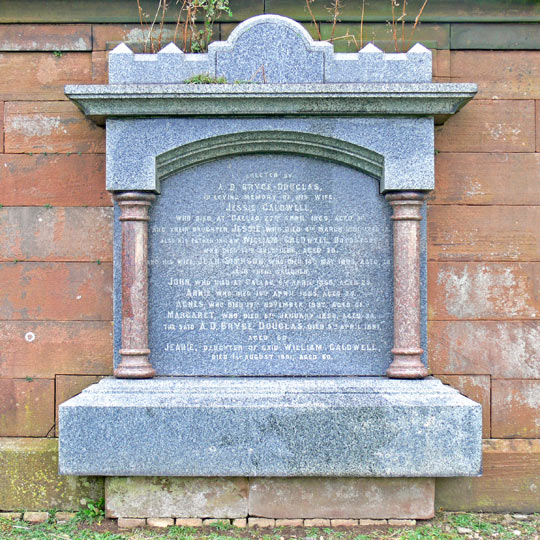
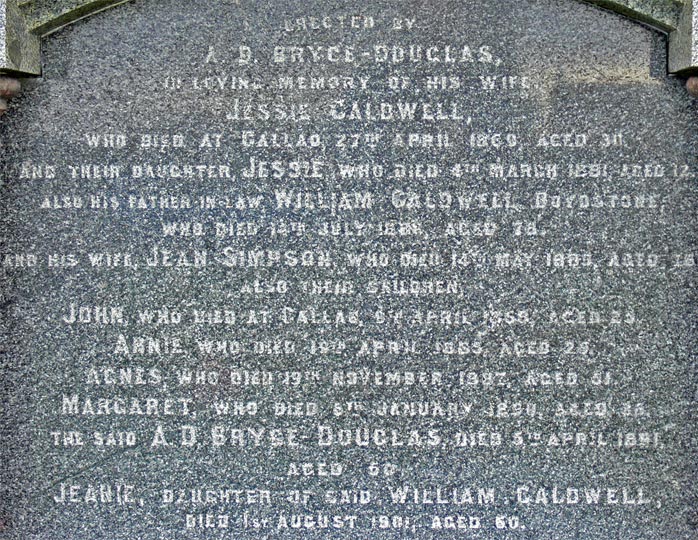
Archibald Douglas Bryce-Douglas's gravestone in Ardrossan
Cemetery is shown above. The inscription is 'Erected by A D Bryce-Douglas in
loving memory of his wife, Jessie Caldwell who died at Calleo, 27 April 1865,
aged 30 and their daughter, Jessie who died 4th March 1881, aged 12; also his
father-in-law, William Caldwell, Boydstone who died 14th July 1886, aged 78
and his wife Jean Simpson who died 14th May 1889, aged 78; also their children
John who died at Calleo, 9th April 1868, aged 25, Annie who died 19th April
1885, aged 26, Margaret who died 6th January 1890, aged 36; the said A D Bryce-Douglas
died 5th April 1891, aged 50; Jeanie, daughter of the said William Caldwell
died 1st August 1901, aged 60'.
MR A D BRYCE-DOUGLAS
The remains of Mr Bryce-Douglas were interred
in Ardrossan Cemetery on Wednesday of last week (8 May 1891) and on each succeeding
day, crowds visited the grave to look upon the floral wreaths sent from workmen
and friends to testify respect for the memory of the dead. On Sabbath (12 April
1891), the numbers who visited the cemetery were unusually large, the visitors
having to wait for some time before they could get near enough to the railing.
The like magnificent wreaths had never before been seen here and what greatly
added to the interest and touched the onlookers most was that the finest and
most beautiful of all the tributes to the worth of the departed, as noticed
last week, were sent by the departments of the Barrow Yard. The floral wreaths
were costly, chaste and beautiful and were made up of the choicest of orchids,
tuberoses, eucharis, lilies, gardenias, splendid nephetos roses, lily of the
valley, freesias, lilium harrisii, stephanotes, cyclamen, white azalea and rhododendrons,
camellias, carnations, white lilac, arum lilies, white narcissus, double white
primulus, myrtle and choice ferns. White and coloured porcelain wreaths, all
under glass globes, have also been sent by the boilermakers, joiners, mechanics
of the shipyard department, patternmakers of the engineering department and
from the workmen of the shipsmiths department all resting upon marble pedestals.
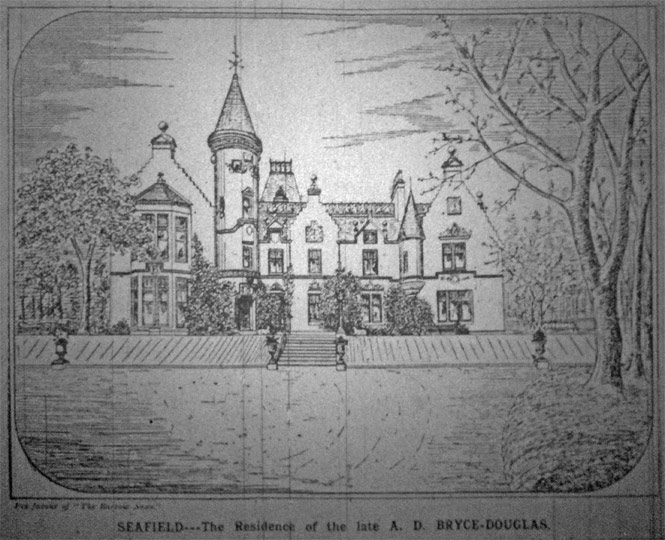
Ardrossan and Saltcoats Herald, 17 April 1891
The picture was 'per favour of The Barrow News'.
INSPECTION OF ARDROSSAN BOYS'
BRIGADE
The First Ardrossan Detachment
of the Boys' Brigade will be inspected in the Ardrossan Academy playground tomorrow
afternoon (16 May 1891) by the honourable Greville Richard Vernon, member of parliament.
The company numbers about sixty, and with the recollection of the pleasant ceremony
witnessed in connection with the same event last year, we recommend our local
readers to avail themselves of the officers' invitation, through our advertising
columns to be present.
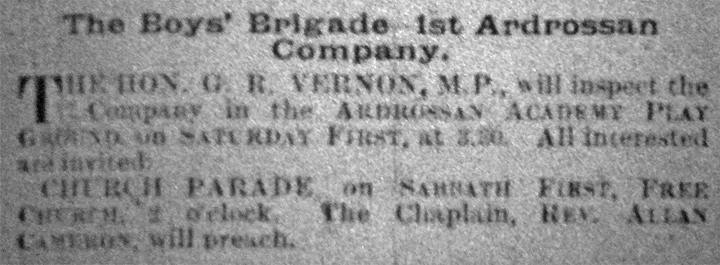
Ardrossan
and Saltcoats Herald, 15 May 1891
IN MEMORIAM - ARCHIBALD DOUGLAS
BRYCE-DOUGLAS, SEAFIELD TOWERS, ARDROSSAN,
LATE MANAGING DIRECTOR, BARROW SHIPBUILDING, ENGINEERING AND NAVAL ARMAMENT
WORKS
Oh death, fell tyrant, yet the friend of man
We bow to thee whom we must all obey
No power on earth can stay thy ruthless hand
But thou shalt yet be honoured in eternitY
Another victim in thy grasp
has gone
Heedless of his brilliant powers
or short-lived years
At thy command he left us all
alone
To mourn his loss and bathe
ourselves in tears
His manly form nor yet his pleasant smile
Can greet nor welcome us for evermore
Gone from amongst us for a little while
But oh we'll meet him yet upon a happier shore
Farewell, dear Bryce, may your
memory live
In loving hearts for many, many
years
Though summoned hence by Him
who reigns above
We drop upon thy grave our bitter,
bitter tears
He needs no flower to deck his peaceful grave
Nor yet a stone to mark his last abode
His memory is on loving hearts engraved
His soul now resteth surely with his God
His old shipmate,
John Fyfe, Johnstone, 1 June 1891
Ardrossan
and Saltcoats Herald, 19 June 1891
EXCELLENT ARDROSSAN BATHS
The very excellent saltwater baths, hot or cold, which may be had from Mr Jackson,
the obliging bathman in charge have been greatly taken advantage of this season.
This is not surprising for the pleasure afforded and the benefit derived are
equally strong factors in inducing repeat visits. Everything pertaining is in
perfect order and the visitors to Ardrossan ought to avail themselves of the
facilities provided.
Ardrossan
and Saltcoats Herald, 28 August 1891
ARDROSSAN NEW DOCKS TO OPEN
NEXT MONTH
At a meeting of the directors of the Ardrossan Harbour Company held in Glasgow
yesterday, it was resolved to formally open the new docks for traffic on Tuesday
20 October. A large number of invitation will be issued to traders and others
to witness the ceremony and the event will be a memorable one in the annals
of Ardrossan. We trust the townspeople will not be slow to show their appreciation
of the benefit conferred upon the town by the undertaking. But for the enlargement
of the harbour, the Lanarkshire and Ayrshire Railway would not have been in
the district and but for these two enterprises, the days of Ardrossan as a commercial
centre were numbered. The handwriting was on the wall. Fortunately, the decadence
was averted. We would suggest the appointment of a representative committee
who will be responsible for making such arrangements as will unmistakably demonstrate
the community's recognition of the Harbour Company's undertaking as a boon and
a blessing.
Ardrossan
and Saltcoats Herald, 11 September 1891
Despite the headline, Eglinton Dock did not open till
12 April 1892.
ARDROSSAN BOWLING, CURLING
AND LAWN TENNIS SMOKING CONCERT
A smoking concert under the auspices of the Ardrossan Bowling, Curling and Lawn
Tennis Clubs promises to be held in the Eglinton Hotel (shown below in the early
1960s) on Friday tonight (2 October 1891) be a success. A good programme has
been prepared and on the same evening, the prizes competed for this season will
be presented.
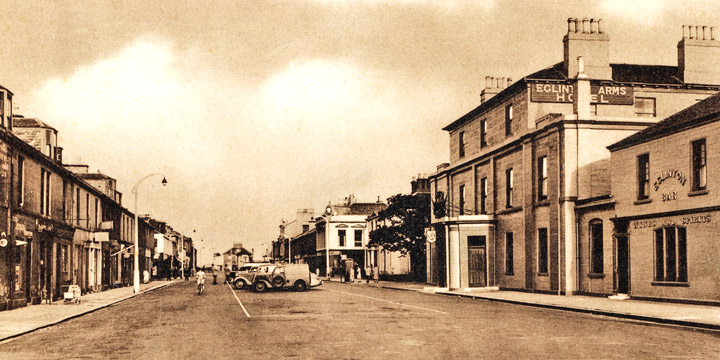
Ardrossan
and Saltcoats Herald, 2 October 1891
BELL-BUOY REFLOATED
The bell-buoy which was driven high up on the North Beach, Ardrossan (shown
below in the early 1910s) by the storm last week was safely floated on Wednesday
(21 October 1891). It was first raised by means of jack-screws after which twelve-inch
planks were inserted and it was borne on rollers far down the beach and floated
when the tide rose.
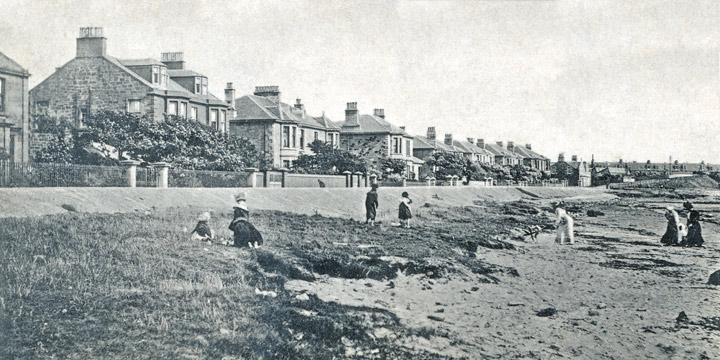
Ardrossan
and Saltcoats Herald, 23 October 1891
OPENING OF THE NEW FILTERS
AT MILL GLEN
These were quietly opened by the Commissioners last Saturday (24 October 1891).
They drove from the Eglinton Hotel (shown two above in the early 1960s) about
two o'clock in the afternoon and they were joined by the farmers on the water
shed when they arrived. The weather was splendid, breathing more of spring than
of late autumn. The water was turned on and the party were highly satisfied
with the result of Mr Urquhart's labours. Provost Hogarth was presented with
the usual silver cup. The works have cost about £4000 and have already
been minutely described in the Herald. Lunch took place in the Mill Glen house.
The construction was from the plans of the well-known firm of Messrs Leslie
and Reid, Edinburgh. The contractor for the construction was Mr James Urquhart,
Glasgow; piping - Messrs McLaren and Son, Port Eglinton Foundry, Glasgow; valves
- Glenfield Company, Kilmarnock and washing boxes and appliances - Mr William
Young, Ardrossan. Full pressure is now enjoyed by the houses in the upper reaches
of the town. After leaving the water works, the party visited the new exhauster
at the gas works. This exhauster cost about £200 and the whole, including
engine and boilers was supplied by Mr William Young, Ardrossan. Now that the
new filters are in operation, Ardrossan has a water supply of which any town
might be proud.
Ardrossan
and Saltcoats Herald, 30 October 1891
ARDROSSAN MUTUAL IMPROVEMENT
ASSOCIATION
The usual meeting of the Association was held in the Free Church Hall (shown
below left as Saint John's Church in 1913) on Wednesday last (11 November 1891).
There was a large attendance, Reverend Allan Cameron, MA (shown below right),
presiding. Mr J D Fullarton read an interesting and exhaustive paper on our
postal system, tracing the development in a graphic and masterly manner and
dwelling at considerable length upon the introduction of the penny post. A few
remarks by several of the members followed the reading of the paper.
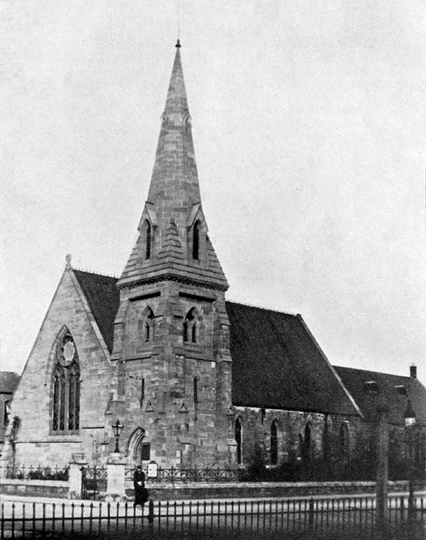
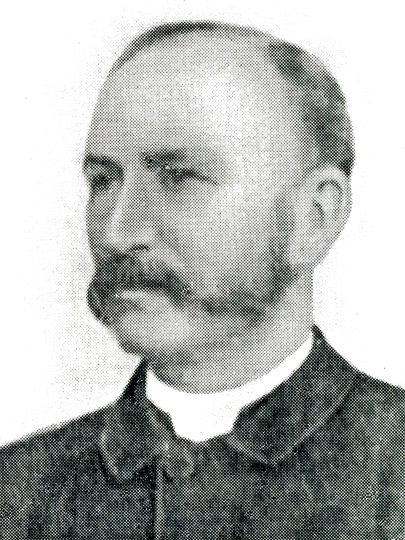
Ardrossan
and Saltcoats Herald, 13 November 1891
ARDROSSAN BURGH A GOOD EXAMPLE
TO OTHERS
It is so seldom that we hear of Ardrossan being held up to other burghs as a
model worthy of imitation that we hail with delight a certificate of merit that
has come from the burgh of Oban. Some time ago, Mr John Alcorn, burgh surveyor
there, visited a number of burghs on the west coast at the request of the Commissioners
to gather information as to the cleaning methods adopted. In a communication
to our Mr Balmer, dated 2 November, he states " I have intimated to the
Police Commissioners here that Ardrossan was the cleanest town I visited.".
Good for Ardrossan! Mr Alcorn's opinion is something to be proud of and we trust
the cleansing department will be energised by the compliment and continue to
deserve such a eulogium.
Ardrossan
and Saltcoats Herald, 13 November 1891
ARDROSSAN MAN BECOMES FIRST-CLASS
ENGINEER
Mr William Wallace, Ardrossan, after a short course of study with Messrs J M
Sothern and Son, Glasgow, has passed the Board of Trade examination for first-class
engineer. Mr Wallace has not to undergo the ordeal twice. It was his first attempt.
Ardrossan
and Saltcoats Herald, 20 November 1891
ARDROSSAN RESCUER REWARDED
Mr Gavin Cross, Ardrossan, third officer on board the steamship Siberian, who
formed one of the seven who rescued the shipwrecked crew of the schooner, Little
Wonder, which was shipwrecked on the North Atlantic on 24 September last has
been awarded a bronze medal and a sum of money by the Board of Trade.
Ardrossan
and Saltcoats Herald, 20 November 1891
ARDROSSAN MAN BUYS NEW STEAMER
Mr Hugh Hogarth, steamship owner, Ardrossan and Glasgow, has purchased a fine
new steamer of 2400 tons deadweight, now in course of construction on 'spec'
by Sir R Dixon and Company at Middlesborough as an addition to the Baron Line.
The price paid for the steamer was about £31500.
Ardrossan
and Saltcoats Herald, 20 November 1891
ARDROSSAN BOYS FINED FOR THROWING
MUD
At the Burgh Court on Monday (30 November 1891), before Provost Hogarth and
Bailie Young, four boys were charged with throwing mud in Glasgow Street, Ardrossan
(shown below in the early 1900s) to the danger and annoyance of passengers.
They were convicted and three who were old offenders were fined five shillings
and the fourth two shillings and sixpence.
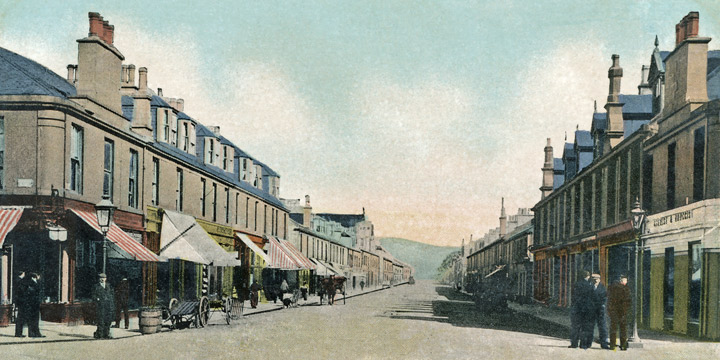
Ardrossan
and Saltcoats Herald, 4 December 1891
CHANGE IN ARDROSSAN POLICE
On Tuesday last (8 November 1891), Constable James Stewart of the Ardrossan
Burgh Police was removed to Tarbolton. Constable Stewart was well-known in the
district and by his departure, a capable and zealous officer has been lost to
the burgh. He is a native of Lanark, we believe, in which town his father was
formerly and brother is now, inspector.
Ardrossan
and Saltcoats Herald, 11 December 1891
SAVAGE ASSAULT
At the Kilmarnock Sheriff Court on Saturday (5 December 1891), a man and
his brother-in-law, both furnace keepers, Ardeer Square, Stevenston, were examined
and committed on a charge of having on the 4 December, near Ardeer Blast Furnace,
savagely assaulted another furnace keeper, residing in the square, by kicking
him repeatedly on the head and body whereby these were severely brusied and
discoloured and one of the ribs on the left side broken. The offence against
the first man was aggravated by previous convictions for assault. We understand
that the victim had given evidence against them in a case in the local court
and they took this as a means of retaliating.
Ardrossan
and Saltcoats Herald, 11 December 1891
NON-CHURCHGOERS
The Reverend J L King, MA, preached on this subject to a large congregation
in Ardrossan Independent Church on Sabbath last (13 December 1891). The theme
was ably dealt with.
Ardrossan
and Saltcoats Herald, 18 December 1891
FIRST
PRIZES FOR ARDROSSAN ARTIST
Mr Andrew Allan, Ardrossan, has again been successful at the School of Art,
obtaining first prize for best series of time sketches from the life and first
for best chalk studies of drapery arranged on a model.
Ardrossan
and Saltcoats Herald, 25 December 1891
Andrew
Allan was born in Ardrossan in 1863, was a student of the Glasgow School
of Art from 1882 to 1896 and went on to become an acknowledged lithographic
artist. He was also mentioned
in the Heralds of 3
February 1893, 16 March 1900 , 30
March 1900 and
18 January 1901.



 On
the morning of Sabbath 29 March, Mr A D Bryce-Douglas (shown right around 1890
from a photograph by John Fergus of Largs) landed at Ardrossan from the Empress
of Japan, then on her trial trip and after a week of severe suffering died at
Seafield Tower, his residence here on the morning of Sabbath last (4 April 1891).
Need we say a shadow of a great sorrow hung over the community of Ardrossan
all week. It was known that Dr Macdonald was in all but constant attendance,
that Dr Moore, Glasgow, made daily visits, that enquiries by telegraph were
coming from all parts of the country and day by day the first enquiry in the
morning and the last at night was an anxious enquiry as to his condition and
this and this anxiety was not to be wondered at. The parish was proud of the
eminence he had attained as a marine engineer. He was the son of their old parish
minister whose qualities as a preacher and freedom from denominational prejudices
were still remembered. He had purchased Seafield Tower because of old it had
been in the family. The poor he had helped. The New Parish Church had the benefit
of his large-hearted generous contributions for late improvements and hundreds
of young men were indebted to him for situations at Fairfield, at Barrow and
in other parts of the world. All this had endeared him to the community. He
was looked up to because of his genius for unquestionably, he was a mechanical
genius of a high order. He was respected for his great administrative abilities
as a large employer. He was one of the kings of labour and liked for his warm-hearted
kindly deeds, his frank intercourse with gentle and simple and his independent
bearing. When his death became known, there was everywhere in the district an
expression of sincere sorrow. It was felt that Commerce had sustained a great
loss and that the poor and the needy were the poorer and the more helpless because
he had passed away. Nor was this feeling confined to his native parish. All
last week, a like anxiety was felt by all classes at Barrow, by Lord Harrington
and the other noblemen and gentlemen associated with him in the works there
and when the news of his death became known, public testimony was borne to the
respect in which he was held by the display of flags half-mast high on public
buildings, on public works, on shipping and elsewhere. Mr Bryce-Douglas was
born at The Manse, Saltcoats on 3 October 1840 being the youngest son of the
late Reverend John Bryce, parish minister of Ardrossan. He was educated at Irvine
Academy under Dr White, master of the Commercial department and afterwards at
Glasgow High School under Dr Bryce, finishing at the university. Like many another
son of the manse, young Bryce was destined by his parents for the ministry of
the church but his bent lay in another direction and as from his earliest days,
he had a mind and a will of his own. His father wisely gave way and allowed
him to carve out his own path through life. Indeed, if it be true that the boy
is father to the man in the case of those who rise to distinction, it was so
in his. 'Still life' was unknown to him as a boy. His restless energy even then
was conspicuous. When seventeen years of age, he was apprenticed to Mr Robert
Drape, joiner, Ardrossan with whom he remained for two years. He also served
for one year as a mill-wright with Mr Hendry, West Kilbride but not yet had
he found his vocation and at the end of that time, he removed to Glasgow and
entered the engineering establishment of Randolph, Elder and Company then situated
in Centre Street, in the evenings attending classes for the study of mechanics
at the Andersonian University. In Messrs Randolph, Elder and Company's employ,
he found congenial work and throwing himself into it with all the ardour of
his nature, he soon attracted the attention of Mr Randolph, the head of the
firm who predicted for him, even at that early age, a distinguished career but
he was not content to remain for more than a few years in the Centre Street
establishment. He had always been possessed by a spirit of adventure and early
in the sixties he shipped as a passenger in a sailing vessel for Auckland where
he had the promise of taking charge of an important machinery plant. On the
way out, the carpenter died and Mr Bryce was offered and accepted the situation
rendered thus vacant. On arriving in New Zealand, the Maori war had just broken
out and taking the situation in at a glance, he soon found an opportunity of
working his passage with a well-known captain with one of our ocean liners to
the Pacific coast. For about a year, he was in the service of the Peruvian Navy
at the end of which time he was offered and accepted a situation as seagoing
engineer with the Pacific Steam Navigation Company. In the year 1865, he revisited
Scotland and after taking a few months with his friends and taking his examination
for extra first-class engineer, in which he was successful, he returned to Callao
to become assistant engineer of the Pacific Company. This position he occupied
till 1869. In that year, the headquarters of the company were removed from the
island of Tobogo in the Bay of Panama to Callao on the establishment of a line
of steamers to sail direct between Liverpool and Valparaiso and a vacancy taking
place at the same time in the office of the superintending engineer through
the resignation of Mr Jamieson. Mr Bryce received the appointment which he held
for a period of six or seven years. On his way home an incident occurred which
was an index of the character of the man. A small coal-laden vessel had stranded
in the Bay of Panama. He took with him, from Callao, a staff of men and the
necessary appliances with the view of raising her. On arriving in the bay, he
learned that the Tagus, one of the Royal Mail Company's steamers had gone ashore
near Colon. Unable, on account of the heavy sea, to accomplish the work he had
come to do, he crossed the Isthmus with his staff and appliances and successfully
carried out the more difficult of raising the Targus. The other vessel was also
raised in due course, Mr Bryce, not only directing, but taking an active part
of working in the diving bells and repairing the hulls, his fertility of resource
being displayed on occasion by the employment of a locomotive to work the pumps.
For the raising of the steamer, the Pacific Company claimed £30000 as
salvage on the ground that Mr Bryce had used their appliance. This claim Mr
Bryce resisted and raised an action in the Court of Session which proved unsuccessful.
On carrying his case, however, to the House of Lords, his contention was partially
sustained and he received a sum of £6000. Shortly after his return to
this country, Mr Bryce resumed his connection with the firm in which he had
received his early training becoming head of the engineering department at the
Fairfield Works which were then carried on under the denomination of Messrs
John Elder and Company. He had found, as told us, the first month of absolute
rest delightful after the close attention of everyday work of previous years,
the second became wearisome and before the close of the third, he was again
glad to be in harness. He remained at the Fairfield Works until he removed to
Barrow in 1888. The history of the Fairfield Works during that period it is
unnecessary to recapitulate. Briefly, it may be stated it was during this time
that the Arizona, Alaska and Oregon and other vessels for the Cunard fleet were
built and that the revolution in the construction of ocean-going steamers, which
has not yet seen its close, was commenced. The whole of these vessels were engined
under the superintendence of Mr Bryce-Douglas as well as the Orient, the Austral
and the Ormuz for the Orient Line. He also constructed the engines for the Czar's
yacht, the Livadin for the Italian iron-clad Magicienne and for several of the
numerous vessels for the British Navy which were turned out of the Fairfield
yard. He also re-engined the Russian warship, Peter The Great. Mr Bryce-Douglas's
connection with Barrow commenced in 1886 when engines of his design were built
under his supervision for the Navigation Steam Navigation Company's Orula and
Orizaba which were constructed by the Barrow Shipbuilding Company. These were
two of the earliest examples of engines of the triple expansion type put into
ocean-going steamers. In 1888, influenced by Lord Harrington and other capitalists,
Mr Bryce-Douglas accepted the position of managing director of the Naval Construction
and Armaments Company which took over the works of the Barrow Shipbuilding Company.
The latter company had all along been an unsuccessful enterprise but, under
the new regime, several and extensions were made and new plant and machinery
were laid down. Important contracts were soon secured which rapidly brought
about a renewal of activity in the shipbuilding and engineering trades of the
port. Among the first orders, Mr Bryce-Douglas procured were four steamers of
large size and full power for the Pacific Steam Navigation Company, a number
of steamers for the British and African Steam Navigation Company and for Messrs
Elder, Dempster and Company of Liverpool. He also obtained the contract for
three second-class cruisers to be built for the Admiralty all of which have
been launched and one, the Latona, delivered while a second cruiser, the Melampus,
will be handed over to the Admiralty at the close of this month. He also undertook
the building of three high-speed 5000 tons steamers for the Caledonian Pacific
Railway Company and intended for the service between Vancouver and Japan and
China. The pioneer of these steamers, the Empress of India, is now on her way
from Hong Kong to Vancouver on her maiden voyage. The sister ship, the Empress
of Japan, ran most successful trials last week as reported in another column
and was taken over by her owners and the third steamer, the Empress of China
was launched a fortnight ago. In the yard, there are at present building nine
steamers of various sizes. There are over 5000 employees in the works and the
weekly payments in the shape of wages amount to about £8500. Thus, if
at Fairfield, Mr Bryce-Douglas made an advance on his achievements on the Pacific
coast by constructing swifter-sailing steamers than companies up till that time
constructed, it was at Barrow where he gave the fullest token of what he was
capable of accomplishing. The directors had the fullest confidence in him, a
confidence justified by his few years of management and with practically a free
hand, he was further a development both as respects increased speed and beneficial
results to commerce and civilisation which would have marked a new era in steam
navigation. Long ago, at Fairfield, the idea was conceived of crossing the Atlantic
by fast-sailing steamers of twin-screw, triple-expansion type from Liverpool
to Canada in five days and then by equally fast-sailing steamers from Vancouver
to Australia thus developing new routes to the east and establishing a new direct
line from England to Australia, crossing the British territory of Canada by
the Canadian Pacific Railway. Last autumn, he visited Canada to take the initiative
in this great scheme and the Premier of the dominion, Mr John MacDonald granted
him a grand subsidy of $750000 per annum for ten years if he would establish
the line. Had he lived to carry out this scheme, it would have been regarded
as one of the greatest conceptions in the history of Commerce and for the sake
of the great works at Barrow, with which from henceforth his name will ever
be connected, it is hoped that the proposed Imperial Steam Navigation Company
will be formed and the enterprise entered upon in the spirit and confidence
which commands success. No better monument could be raised to the memory of
him whom Lord Brassey, at the launch of the cruiser Naiad, said was "a
great benefactor to the place" than by realising his dream and for which
it is said he had secured nigh a million of money. The immediate cause of death
was a cold caught, it is believed, at the launch of the Empress of China and
which developed into peritonitis. He was ill on board and was prescribed for
by a medical gentleman of the party and when he landed at Ardrossan on a bitterly
cold morning, he was able to walk to Seafield. No time was lost in calling in
medical aid and all that human skill and good nursing could do was done for
him. The inflammation, however, had got too firm a hold and a constitution,
remarkable for its strength, succumbed and at the comparatively early age of
fifty, a life of much usefulness and still greater promise came to a close.
He had probably when at sea faced death too often to dread the approach at the
last. This at least is certain, that when told the illness might have a fatal
termination, he received the tidings with the greatest calmness and with the
utmost composure, awaited the end. Beside possessing several patents, Mr Bryce-Douglas
was proprietor of Seafield, Ardrossan (shown below left as Quarriers in 2008)
which he purchased from the liquidation of the City of Glasgow Bank and greatly
enlarged and beautified.
On
the morning of Sabbath 29 March, Mr A D Bryce-Douglas (shown right around 1890
from a photograph by John Fergus of Largs) landed at Ardrossan from the Empress
of Japan, then on her trial trip and after a week of severe suffering died at
Seafield Tower, his residence here on the morning of Sabbath last (4 April 1891).
Need we say a shadow of a great sorrow hung over the community of Ardrossan
all week. It was known that Dr Macdonald was in all but constant attendance,
that Dr Moore, Glasgow, made daily visits, that enquiries by telegraph were
coming from all parts of the country and day by day the first enquiry in the
morning and the last at night was an anxious enquiry as to his condition and
this and this anxiety was not to be wondered at. The parish was proud of the
eminence he had attained as a marine engineer. He was the son of their old parish
minister whose qualities as a preacher and freedom from denominational prejudices
were still remembered. He had purchased Seafield Tower because of old it had
been in the family. The poor he had helped. The New Parish Church had the benefit
of his large-hearted generous contributions for late improvements and hundreds
of young men were indebted to him for situations at Fairfield, at Barrow and
in other parts of the world. All this had endeared him to the community. He
was looked up to because of his genius for unquestionably, he was a mechanical
genius of a high order. He was respected for his great administrative abilities
as a large employer. He was one of the kings of labour and liked for his warm-hearted
kindly deeds, his frank intercourse with gentle and simple and his independent
bearing. When his death became known, there was everywhere in the district an
expression of sincere sorrow. It was felt that Commerce had sustained a great
loss and that the poor and the needy were the poorer and the more helpless because
he had passed away. Nor was this feeling confined to his native parish. All
last week, a like anxiety was felt by all classes at Barrow, by Lord Harrington
and the other noblemen and gentlemen associated with him in the works there
and when the news of his death became known, public testimony was borne to the
respect in which he was held by the display of flags half-mast high on public
buildings, on public works, on shipping and elsewhere. Mr Bryce-Douglas was
born at The Manse, Saltcoats on 3 October 1840 being the youngest son of the
late Reverend John Bryce, parish minister of Ardrossan. He was educated at Irvine
Academy under Dr White, master of the Commercial department and afterwards at
Glasgow High School under Dr Bryce, finishing at the university. Like many another
son of the manse, young Bryce was destined by his parents for the ministry of
the church but his bent lay in another direction and as from his earliest days,
he had a mind and a will of his own. His father wisely gave way and allowed
him to carve out his own path through life. Indeed, if it be true that the boy
is father to the man in the case of those who rise to distinction, it was so
in his. 'Still life' was unknown to him as a boy. His restless energy even then
was conspicuous. When seventeen years of age, he was apprenticed to Mr Robert
Drape, joiner, Ardrossan with whom he remained for two years. He also served
for one year as a mill-wright with Mr Hendry, West Kilbride but not yet had
he found his vocation and at the end of that time, he removed to Glasgow and
entered the engineering establishment of Randolph, Elder and Company then situated
in Centre Street, in the evenings attending classes for the study of mechanics
at the Andersonian University. In Messrs Randolph, Elder and Company's employ,
he found congenial work and throwing himself into it with all the ardour of
his nature, he soon attracted the attention of Mr Randolph, the head of the
firm who predicted for him, even at that early age, a distinguished career but
he was not content to remain for more than a few years in the Centre Street
establishment. He had always been possessed by a spirit of adventure and early
in the sixties he shipped as a passenger in a sailing vessel for Auckland where
he had the promise of taking charge of an important machinery plant. On the
way out, the carpenter died and Mr Bryce was offered and accepted the situation
rendered thus vacant. On arriving in New Zealand, the Maori war had just broken
out and taking the situation in at a glance, he soon found an opportunity of
working his passage with a well-known captain with one of our ocean liners to
the Pacific coast. For about a year, he was in the service of the Peruvian Navy
at the end of which time he was offered and accepted a situation as seagoing
engineer with the Pacific Steam Navigation Company. In the year 1865, he revisited
Scotland and after taking a few months with his friends and taking his examination
for extra first-class engineer, in which he was successful, he returned to Callao
to become assistant engineer of the Pacific Company. This position he occupied
till 1869. In that year, the headquarters of the company were removed from the
island of Tobogo in the Bay of Panama to Callao on the establishment of a line
of steamers to sail direct between Liverpool and Valparaiso and a vacancy taking
place at the same time in the office of the superintending engineer through
the resignation of Mr Jamieson. Mr Bryce received the appointment which he held
for a period of six or seven years. On his way home an incident occurred which
was an index of the character of the man. A small coal-laden vessel had stranded
in the Bay of Panama. He took with him, from Callao, a staff of men and the
necessary appliances with the view of raising her. On arriving in the bay, he
learned that the Tagus, one of the Royal Mail Company's steamers had gone ashore
near Colon. Unable, on account of the heavy sea, to accomplish the work he had
come to do, he crossed the Isthmus with his staff and appliances and successfully
carried out the more difficult of raising the Targus. The other vessel was also
raised in due course, Mr Bryce, not only directing, but taking an active part
of working in the diving bells and repairing the hulls, his fertility of resource
being displayed on occasion by the employment of a locomotive to work the pumps.
For the raising of the steamer, the Pacific Company claimed £30000 as
salvage on the ground that Mr Bryce had used their appliance. This claim Mr
Bryce resisted and raised an action in the Court of Session which proved unsuccessful.
On carrying his case, however, to the House of Lords, his contention was partially
sustained and he received a sum of £6000. Shortly after his return to
this country, Mr Bryce resumed his connection with the firm in which he had
received his early training becoming head of the engineering department at the
Fairfield Works which were then carried on under the denomination of Messrs
John Elder and Company. He had found, as told us, the first month of absolute
rest delightful after the close attention of everyday work of previous years,
the second became wearisome and before the close of the third, he was again
glad to be in harness. He remained at the Fairfield Works until he removed to
Barrow in 1888. The history of the Fairfield Works during that period it is
unnecessary to recapitulate. Briefly, it may be stated it was during this time
that the Arizona, Alaska and Oregon and other vessels for the Cunard fleet were
built and that the revolution in the construction of ocean-going steamers, which
has not yet seen its close, was commenced. The whole of these vessels were engined
under the superintendence of Mr Bryce-Douglas as well as the Orient, the Austral
and the Ormuz for the Orient Line. He also constructed the engines for the Czar's
yacht, the Livadin for the Italian iron-clad Magicienne and for several of the
numerous vessels for the British Navy which were turned out of the Fairfield
yard. He also re-engined the Russian warship, Peter The Great. Mr Bryce-Douglas's
connection with Barrow commenced in 1886 when engines of his design were built
under his supervision for the Navigation Steam Navigation Company's Orula and
Orizaba which were constructed by the Barrow Shipbuilding Company. These were
two of the earliest examples of engines of the triple expansion type put into
ocean-going steamers. In 1888, influenced by Lord Harrington and other capitalists,
Mr Bryce-Douglas accepted the position of managing director of the Naval Construction
and Armaments Company which took over the works of the Barrow Shipbuilding Company.
The latter company had all along been an unsuccessful enterprise but, under
the new regime, several and extensions were made and new plant and machinery
were laid down. Important contracts were soon secured which rapidly brought
about a renewal of activity in the shipbuilding and engineering trades of the
port. Among the first orders, Mr Bryce-Douglas procured were four steamers of
large size and full power for the Pacific Steam Navigation Company, a number
of steamers for the British and African Steam Navigation Company and for Messrs
Elder, Dempster and Company of Liverpool. He also obtained the contract for
three second-class cruisers to be built for the Admiralty all of which have
been launched and one, the Latona, delivered while a second cruiser, the Melampus,
will be handed over to the Admiralty at the close of this month. He also undertook
the building of three high-speed 5000 tons steamers for the Caledonian Pacific
Railway Company and intended for the service between Vancouver and Japan and
China. The pioneer of these steamers, the Empress of India, is now on her way
from Hong Kong to Vancouver on her maiden voyage. The sister ship, the Empress
of Japan, ran most successful trials last week as reported in another column
and was taken over by her owners and the third steamer, the Empress of China
was launched a fortnight ago. In the yard, there are at present building nine
steamers of various sizes. There are over 5000 employees in the works and the
weekly payments in the shape of wages amount to about £8500. Thus, if
at Fairfield, Mr Bryce-Douglas made an advance on his achievements on the Pacific
coast by constructing swifter-sailing steamers than companies up till that time
constructed, it was at Barrow where he gave the fullest token of what he was
capable of accomplishing. The directors had the fullest confidence in him, a
confidence justified by his few years of management and with practically a free
hand, he was further a development both as respects increased speed and beneficial
results to commerce and civilisation which would have marked a new era in steam
navigation. Long ago, at Fairfield, the idea was conceived of crossing the Atlantic
by fast-sailing steamers of twin-screw, triple-expansion type from Liverpool
to Canada in five days and then by equally fast-sailing steamers from Vancouver
to Australia thus developing new routes to the east and establishing a new direct
line from England to Australia, crossing the British territory of Canada by
the Canadian Pacific Railway. Last autumn, he visited Canada to take the initiative
in this great scheme and the Premier of the dominion, Mr John MacDonald granted
him a grand subsidy of $750000 per annum for ten years if he would establish
the line. Had he lived to carry out this scheme, it would have been regarded
as one of the greatest conceptions in the history of Commerce and for the sake
of the great works at Barrow, with which from henceforth his name will ever
be connected, it is hoped that the proposed Imperial Steam Navigation Company
will be formed and the enterprise entered upon in the spirit and confidence
which commands success. No better monument could be raised to the memory of
him whom Lord Brassey, at the launch of the cruiser Naiad, said was "a
great benefactor to the place" than by realising his dream and for which
it is said he had secured nigh a million of money. The immediate cause of death
was a cold caught, it is believed, at the launch of the Empress of China and
which developed into peritonitis. He was ill on board and was prescribed for
by a medical gentleman of the party and when he landed at Ardrossan on a bitterly
cold morning, he was able to walk to Seafield. No time was lost in calling in
medical aid and all that human skill and good nursing could do was done for
him. The inflammation, however, had got too firm a hold and a constitution,
remarkable for its strength, succumbed and at the comparatively early age of
fifty, a life of much usefulness and still greater promise came to a close.
He had probably when at sea faced death too often to dread the approach at the
last. This at least is certain, that when told the illness might have a fatal
termination, he received the tidings with the greatest calmness and with the
utmost composure, awaited the end. Beside possessing several patents, Mr Bryce-Douglas
was proprietor of Seafield, Ardrossan (shown below left as Quarriers in 2008)
which he purchased from the liquidation of the City of Glasgow Bank and greatly
enlarged and beautified.









